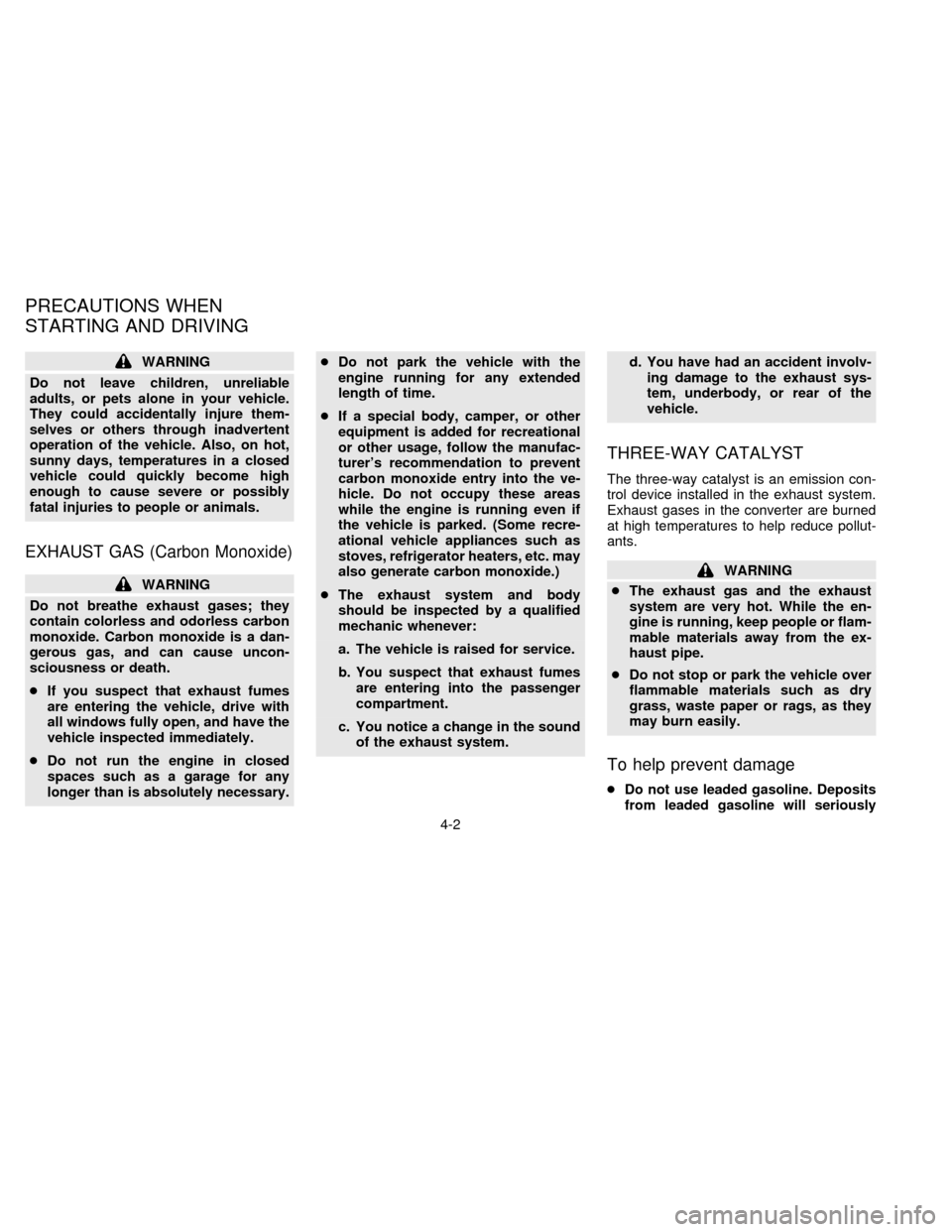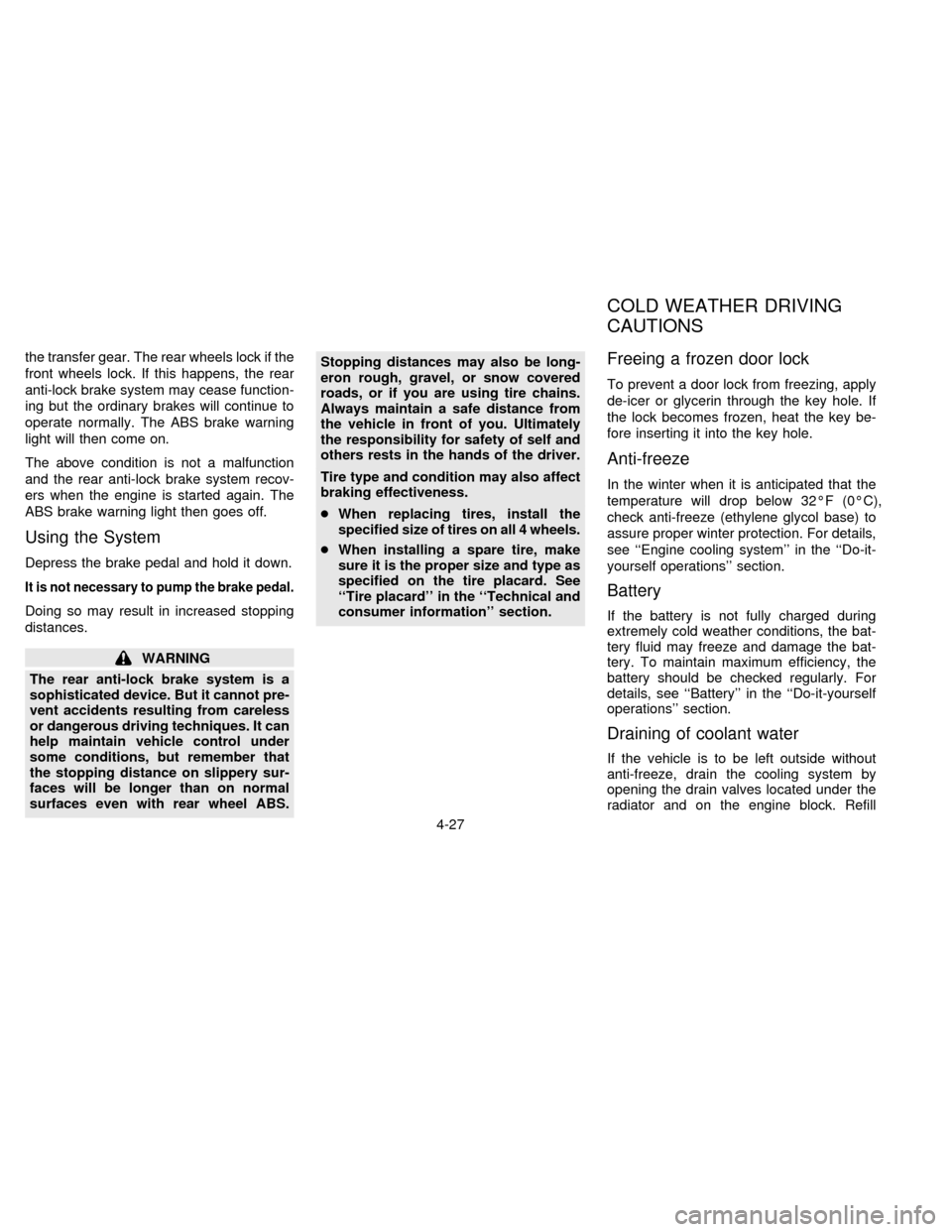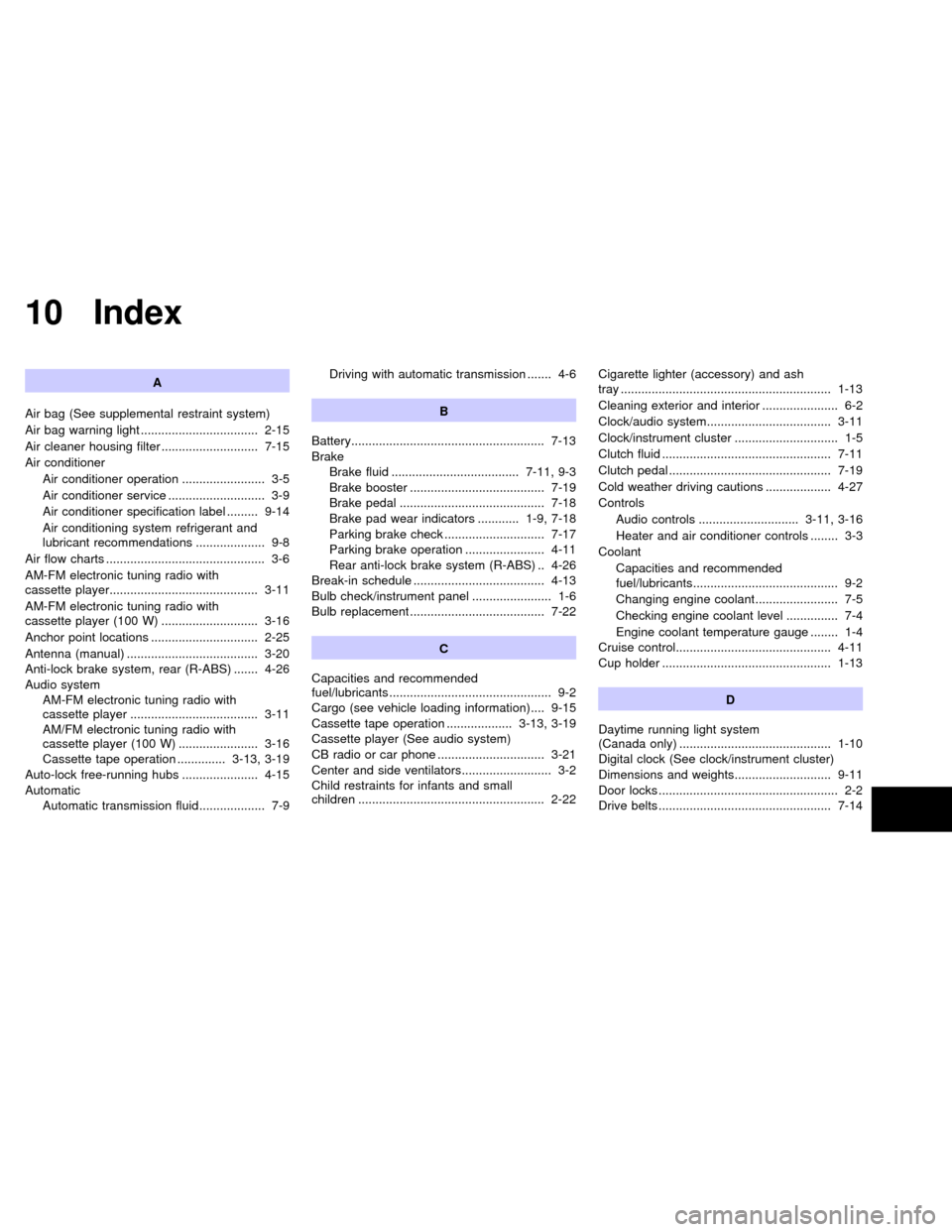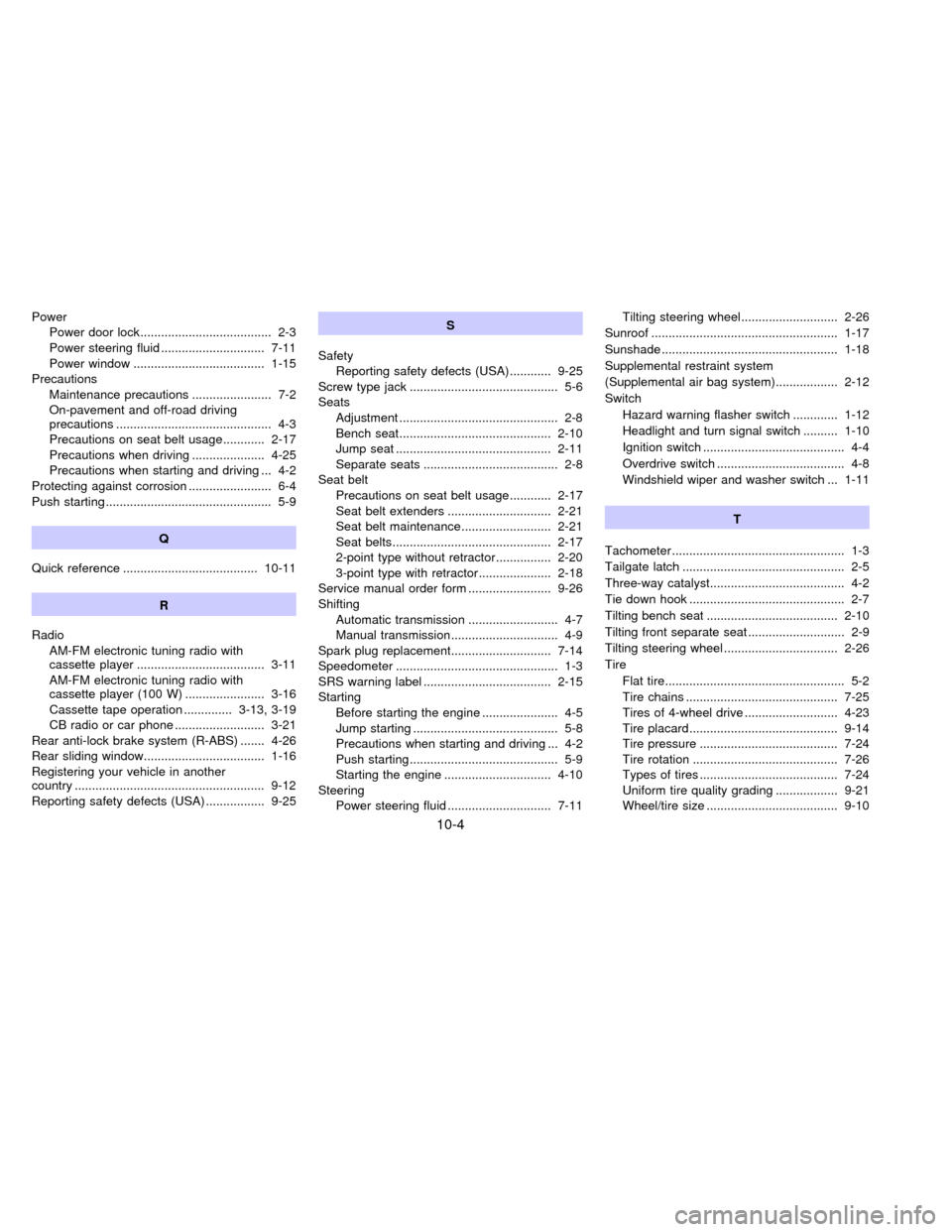1996 NISSAN FRONTIER ABS
[x] Cancel search: ABSPage 45 of 198

To increase your confidence in the belts,
check the operation as follows:
cGrasp the shoulder belt and pull quickly
forward. The retractor should lock and
restrict further belt movement.
If the retractor does not lock during this
check or if you have any question about belt
operation, see your NISSAN dealer.
Replacing front seat belt (3-point
type only)
The front seat belts are shock absorber
types. Replace the belt when the loop has
been pulled out and ``REPLACE BELT'' is
visible. This indicator means the seat belt
has been overstressed.
2-POINT TYPE WITHOUT
RETRACTOR (Center of bench
seat)
The center seat belt buckle and tongue are
identified by the CENTER mark. The center
seat belt tongue can be fastened only into
the center seat belt buckle.
Fastening the belts
1. Insert the tongue into the buckle until it
snaps.2. To lengthen, hold the tongue at a right
angle to the belt and pull on the belt. To
shorten, pull the free end of the belt away
from the tongue, then pull the belt clip to
take up the slack.
MPA0005MPA0006
2-20
ZX
Page 77 of 198

WARNING
Do not leave children, unreliable
adults, or pets alone in your vehicle.
They could accidentally injure them-
selves or others through inadvertent
operation of the vehicle. Also, on hot,
sunny days, temperatures in a closed
vehicle could quickly become high
enough to cause severe or possibly
fatal injuries to people or animals.
EXHAUST GAS (Carbon Monoxide)
WARNING
Do not breathe exhaust gases; they
contain colorless and odorless carbon
monoxide. Carbon monoxide is a dan-
gerous gas, and can cause uncon-
sciousness or death.
cIf you suspect that exhaust fumes
are entering the vehicle, drive with
all windows fully open, and have the
vehicle inspected immediately.
cDo not run the engine in closed
spaces such as a garage for any
longer than is absolutely necessary.cDo not park the vehicle with the
engine running for any extended
length of time.
cIf a special body, camper, or other
equipment is added for recreational
or other usage, follow the manufac-
turer's recommendation to prevent
carbon monoxide entry into the ve-
hicle. Do not occupy these areas
while the engine is running even if
the vehicle is parked. (Some recre-
ational vehicle appliances such as
stoves, refrigerator heaters, etc. may
also generate carbon monoxide.)
cThe exhaust system and body
should be inspected by a qualified
mechanic whenever:
a. The vehicle is raised for service.
b. You suspect that exhaust fumes
are entering into the passenger
compartment.
c. You notice a change in the sound
of the exhaust system.d. You have had an accident involv-
ing damage to the exhaust sys-
tem, underbody, or rear of the
vehicle.
THREE-WAY CATALYST
The three-way catalyst is an emission con-
trol device installed in the exhaust system.
Exhaust gases in the converter are burned
at high temperatures to help reduce pollut-
ants.
WARNING
cThe exhaust gas and the exhaust
system are very hot. While the en-
gine is running, keep people or flam-
mable materials away from the ex-
haust pipe.
cDo not stop or park the vehicle over
flammable materials such as dry
grass, waste paper or rags, as they
may burn easily.
To help prevent damage
cDo not use leaded gasoline. Deposits
from leaded gasoline will seriously
PRECAUTIONS WHEN
STARTING AND DRIVING
4-2
ZX
Page 101 of 198

the brakes return to normal. Avoid driving
the vehicle at high speeds until the
brakes function correctly.
cAvoid resting your foot on the brake
pedal while driving. This will overheat the
brakes, wear out the brake linings and
pads faster and reduce gas mileage.
cTo help reduce brake wear and to pre-
vent the brakes from overheating, before
going down a slope or long grade, reduce
speed and downshift to a lower gear.
cWhile driving on a slippery surface, be
careful when braking, accelerating or
downshifting. Abrupt braking actions or
sudden acceleration could cause the
wheels to skid.Normal Operation
The anti-lock brake system does not oper-
ate at speeds below 3 to 6 MPH (5 to 10
km/h). (The speeds vary according to road
conditions.)
When driving in the 2-wheel drive mode, the
rear anti-lock brake system controls the rear
wheels so they will not lock when braking
abruptly or when braking on a slippery road.
Thus, difficult steering and swerving of the
vehicle due to locked rear wheels is mini-
mized. The system detects the rear wheel
rotation rate and electronically controls the
pressure applied to each rear brake. Slight
vibration on the brake pedal accompanied
by noise usually occurs while the ABS sys-
tem is operating. Such vibration and noise
encountered during abrupt braking is not a
problem, but indicates that the system is
functioning.
Even with the rear anti-lock brake sys-
tem, your front wheels can still lock. If
this happens, release the brake pedal
slightly and then reapply pressure.
Self-test feature
The rear anti-lock brake system consists of
an electronic sensor and two hydraulic so-lenoids controlled by a computer. The com-
puter has a built-in diagnostic feature that
tests the system each time you start the
engine and move the vehicle at a low speed
in forward or reverse. When the self-test
occurs, you may hear a ``clunk'' noise
and/or feel a ``pulsation'' in the brake pedal.
This is normal and is not an indication of any
malfunction. If the computer senses any
malfunction, it switches the rear anti-lock
brake system off and turns on the ABS
brake warning light in the dashboard. The
brake system then operates normally, but
without anti-lock assistance.
If an abnormality occurs in the system, the rear
anti-lock function will cease but the ordinary
brakes will continue to operate normally. The
ABS brake warning light will then come on.
If the light comes on while you are driving,
contact your NISSAN dealer for repair.
The rear anti-lock brake system
may only be effective when driving in the
2-wheel drive mode.
When driving in the 4-wheel drive mode, the
rear anti-lock brake system may not be
effective in many cases because the front
axle is connected with the rear axle through
REAR ANTI-LOCK BRAKE
SYSTEM (R-ABS)
4-26
ZX
Page 102 of 198

the transfer gear. The rear wheels lock if the
front wheels lock. If this happens, the rear
anti-lock brake system may cease function-
ing but the ordinary brakes will continue to
operate normally. The ABS brake warning
light will then come on.
The above condition is not a malfunction
and the rear anti-lock brake system recov-
ers when the engine is started again. The
ABS brake warning light then goes off.
Using the System
Depress the brake pedal and hold it down.
It is not necessary to pump the brake pedal.
Doing so may result in increased stopping
distances.
WARNING
The rear anti-lock brake system is a
sophisticated device. But it cannot pre-
vent accidents resulting from careless
or dangerous driving techniques. It can
help maintain vehicle control under
some conditions, but remember that
the stopping distance on slippery sur-
faces will be longer than on normal
surfaces even with rear wheel ABS.Stopping distances may also be long-
eron rough, gravel, or snow covered
roads, or if you are using tire chains.
Always maintain a safe distance from
the vehicle in front of you. Ultimately
the responsibility for safety of self and
others rests in the hands of the driver.
Tire type and condition may also affect
braking effectiveness.
cWhen replacing tires, install the
specified size of tires on all 4 wheels.
cWhen installing a spare tire, make
sure it is the proper size and type as
specified on the tire placard. See
``Tire placard'' in the ``Technical and
consumer information'' section.
Freeing a frozen door lock
To prevent a door lock from freezing, apply
de-icer or glycerin through the key hole. If
the lock becomes frozen, heat the key be-
fore inserting it into the key hole.
Anti-freeze
In the winter when it is anticipated that the
temperature will drop below 32ÉF (0ÉC),
check anti-freeze (ethylene glycol base) to
assure proper winter protection. For details,
see ``Engine cooling system'' in the ``Do-it-
yourself operations'' section.
Battery
If the battery is not fully charged during
extremely cold weather conditions, the bat-
tery fluid may freeze and damage the bat-
tery. To maintain maximum efficiency, the
battery should be checked regularly. For
details, see ``Battery'' in the ``Do-it-yourself
operations'' section.
Draining of coolant water
If the vehicle is to be left outside without
anti-freeze, drain the cooling system by
opening the drain valves located under the
radiator and on the engine block. Refill
COLD WEATHER DRIVING
CAUTIONS
4-27
ZX
Page 192 of 198

10 Index
A
Air bag (See supplemental restraint system)
Air bag warning light .................................. 2-15
Air cleaner housing filter ............................ 7-15
Air conditioner
Air conditioner operation ........................ 3-5
Air conditioner service ............................ 3-9
Air conditioner specification label ......... 9-14
Air conditioning system refrigerant and
lubricant recommendations .................... 9-8
Air flow charts .............................................. 3-6
AM-FM electronic tuning radio with
cassette player........................................... 3-11
AM-FM electronic tuning radio with
cassette player (100 W) ............................ 3-16
Anchor point locations ............................... 2-25
Antenna (manual) ...................................... 3-20
Anti-lock brake system, rear (R-ABS) ....... 4-26
Audio system
AM-FM electronic tuning radio with
cassette player ..................................... 3-11
AM/FM electronic tuning radio with
cassette player (100 W) ....................... 3-16
Cassette tape operation .............. 3-13, 3-19
Auto-lock free-running hubs ...................... 4-15
Automatic
Automatic transmission fluid ................... 7-9Driving with automatic transmission ....... 4-6
B
Battery........................................................ 7-13
Brake
Brake fluid ..................................... 7-11, 9-3
Brake booster ....................................... 7-19
Brake pedal .......................................... 7-18
Brake pad wear indicators ............ 1-9, 7-18
Parking brake check ............................. 7-17
Parking brake operation ....................... 4-11
Rear anti-lock brake system (R-ABS) .. 4-26
Break-in schedule ...................................... 4-13
Bulb check/instrument panel ....................... 1-6
Bulb replacement ....................................... 7-22
C
Capacities and recommended
fuel/lubricants ............................................... 9-2
Cargo (see vehicle loading information).... 9-15
Cassette tape operation ................... 3-13, 3-19
Cassette player (See audio system)
CB radio or car phone ............................... 3-21
Center and side ventilators.......................... 3-2
Child restraints for infants and small
children ...................................................... 2-22Cigarette lighter (accessory) and ash
tray ............................................................. 1-13
Cleaning exterior and interior ...................... 6-2
Clock/audio system.................................... 3-11
Clock/instrument cluster .............................. 1-5
Clutch fluid ................................................. 7-11
Clutch pedal ............................................... 7-19
Cold weather driving cautions ................... 4-27
Controls
Audio controls ............................. 3-11, 3-16
Heater and air conditioner controls ........ 3-3
Coolant
Capacities and recommended
fuel/lubricants.......................................... 9-2
Changing engine coolant........................ 7-5
Checking engine coolant level ............... 7-4
Engine coolant temperature gauge ........ 1-4
Cruise control............................................. 4-11
Cup holder ................................................. 1-13
D
Daytime running light system
(Canada only) ............................................ 1-10
Digital clock (See clock/instrument cluster)
Dimensions and weights............................ 9-11
Door locks .................................................... 2-2
Drive belts .................................................. 7-14
ZX
Page 195 of 198

Power
Power door lock...................................... 2-3
Power steering fluid .............................. 7-11
Power window ...................................... 1-15
Precautions
Maintenance precautions ....................... 7-2
On-pavement and off-road driving
precautions ............................................. 4-3
Precautions on seat belt usage............ 2-17
Precautions when driving ..................... 4-25
Precautions when starting and driving ... 4-2
Protecting against corrosion ........................ 6-4
Push starting ................................................ 5-9
Q
Quick reference ....................................... 10-11
R
Radio
AM-FM electronic tuning radio with
cassette player ..................................... 3-11
AM-FM electronic tuning radio with
cassette player (100 W) ....................... 3-16
Cassette tape operation .............. 3-13, 3-19
CB radio or car phone .......................... 3-21
Rear anti-lock brake system (R-ABS) ....... 4-26
Rear sliding window................................... 1-16
Registering your vehicle in another
country ....................................................... 9-12
Reporting safety defects (USA) ................. 9-25S
Safety
Reporting safety defects (USA) ............ 9-25
Screw type jack ........................................... 5-6
Seats
Adjustment .............................................. 2-8
Bench seat............................................ 2-10
Jump seat ............................................. 2-11
Separate seats ....................................... 2-8
Seat belt
Precautions on seat belt usage............ 2-17
Seat belt extenders .............................. 2-21
Seat belt maintenance.......................... 2-21
Seat belts.............................................. 2-17
2-point type without retractor................ 2-20
3-point type with retractor..................... 2-18
Service manual order form ........................ 9-26
Shifting
Automatic transmission .......................... 4-7
Manual transmission............................... 4-9
Spark plug replacement............................. 7-14
Speedometer ............................................... 1-3
SRS warning label ..................................... 2-15
Starting
Before starting the engine ...................... 4-5
Jump starting .......................................... 5-8
Precautions when starting and driving ... 4-2
Push starting........................................... 5-9
Starting the engine ............................... 4-10
Steering
Power steering fluid .............................. 7-11Tilting steering wheel............................ 2-26
Sunroof ...................................................... 1-17
Sunshade ................................................... 1-18
Supplemental restraint system
(Supplemental air bag system).................. 2-12
Switch
Hazard warning flasher switch ............. 1-12
Headlight and turn signal switch .......... 1-10
Ignition switch ......................................... 4-4
Overdrive switch ..................................... 4-8
Windshield wiper and washer switch ... 1-11
T
Tachometer .................................................. 1-3
Tailgate latch ............................................... 2-5
Three-way catalyst....................................... 4-2
Tie down hook ............................................. 2-7
Tilting bench seat ...................................... 2-10
Tilting front separate seat ............................ 2-9
Tilting steering wheel ................................. 2-26
Tire
Flat tire.................................................... 5-2
Tire chains ............................................ 7-25
Tires of 4-wheel drive ........................... 4-23
Tire placard........................................... 9-14
Tire pressure ........................................ 7-24
Tire rotation .......................................... 7-26
Types of tires ........................................ 7-24
Uniform tire quality grading .................. 9-21
Wheel/tire size ...................................... 9-10
10-4
ZX